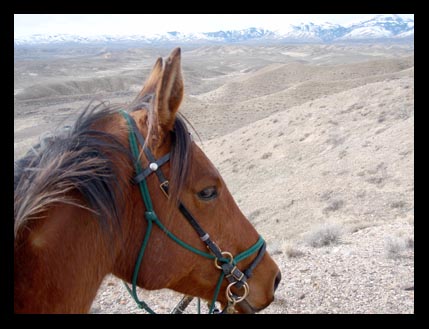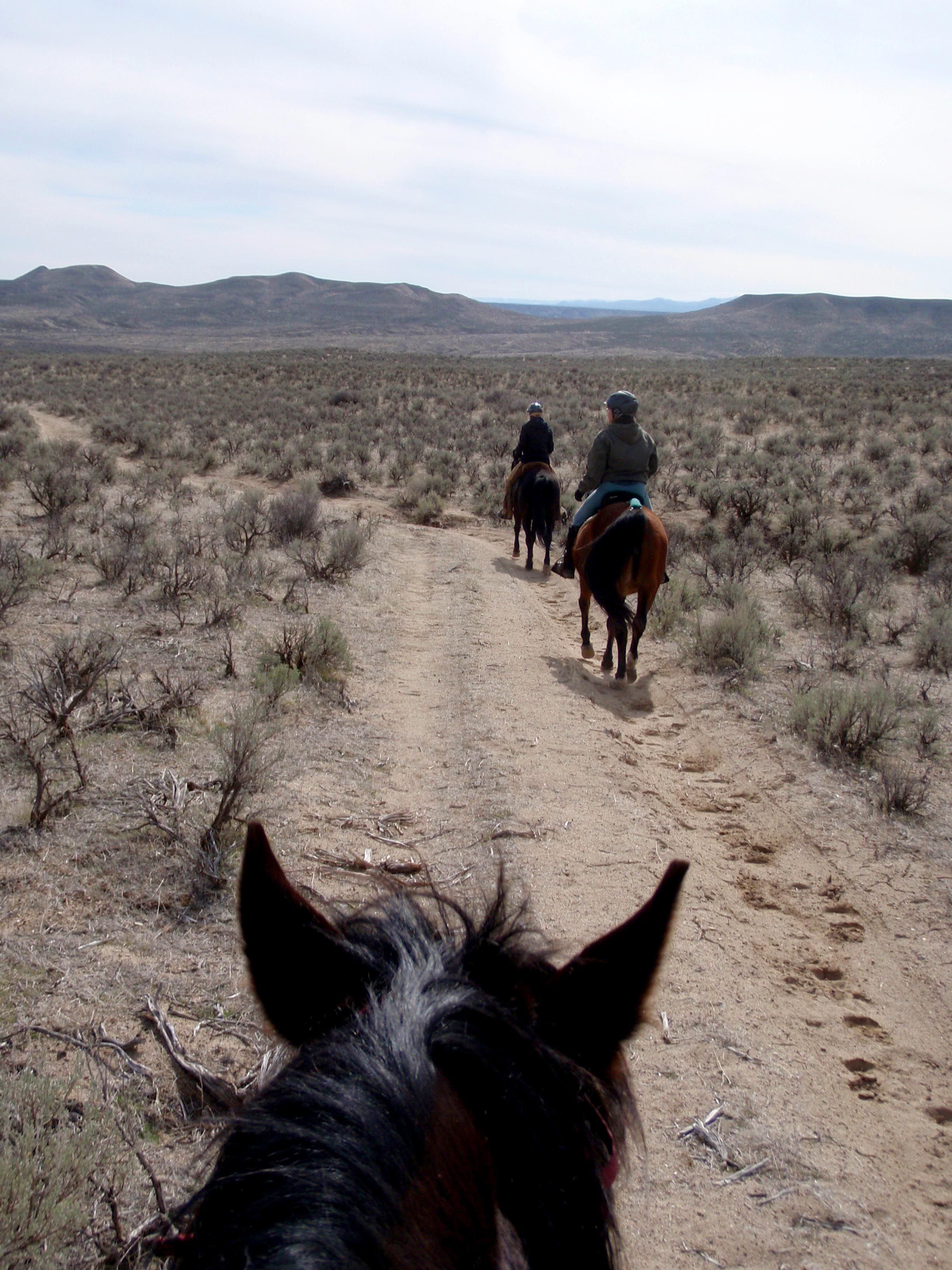
Saturday March 12 2011
Since it's that time of year for many riders – time to get back in the saddle and get your blubbery horses back into shape, I'll have a few articles and links on conditioning horses. The following is a general training article of mine that was originally printed in Trail Blazer magazine in 2007.
Shape Up!
You’re one of those riders who doesn't enjoy the confinement of an arena. Your horse doesn’t take well to it either. You love the outdoors and can really think of nothing better to do than spend all day in the open spaces with your horse. Maybe you’d like to have the option of adding competition to your riding repertoire. But how do you get there from here?
Whether your goal is to participate in competitive trail rides, endurance rides, or just pleasurable trail rides, start with the fundamentals of building a solid foundation of physical conditioning and mental training underneath your horse. Getting your horse fit and confident to handle any challenge, physical and psychological, is essential to a thriving partnership and success on the trail.
PART I
CONDITIONING: LET’S GET PHYSICAL
Conditioning is subjecting the horse to the stress of exercise, in gradually increasing workloads over time, allowing the horse’s body systems time to adapt to each increase. This process is known as progressive loading. Not only will it maximize the horse’s performance, but will also help keep the horse sound. Increasing workloads means slow and steady increase in either the duration of exercise, or the speed of exercise, but not both at the same time, approximately every week.
You have an advantage if you are working with an older horse who has previously had an athletic career. His body has already been accustomed to the conditioning program, so you won’t be starting from scratch, as you would with a youngster or an older horse that has never had any kind of physical training.
What type of horse do you need for success? “Any breed of horse and any discipline of riding can compete at the North American Trail Ride Conference Novice level as long as the physical and mental preparations are made to compete at 20 to 25 miles,” says Lynn Smothermon, a recreational/competitive trail trainer in Orange, California. The same applies to limited distance endurance rides and pleasure trail rides - any breed can be successful. While Arabian horses have proven best in general for long distance endurance rides, there are of course exceptions; every horse is an individual, and some may naturally do better than others despite their breeding.
Patience is a key to conditioning; it is tempting to start too soon and do too much too fast. It can take 2 to 3 years to fully condition a horse’s body systems. The cardiovascular system is the first to whip into shape. In approximately 6 months, your horse may stop huffing and puffing so hard after a workout, and he may appear to be in shape. But it’s the other systems that need the most nurturing and that take the longest to come round. According to Dr Nancy Loving, DVM, it can take ligaments and tendons 6 to 12 months to fully develop, and it can take up to 1 to 2 years for the conditioning of bone.
FAST IS SLOW
Ask ten different trainers, and they will give you ten very different plans for properly and carefully conditioning your trail horse. While methods always vary, the basic underlying theme and key to getting your horse fit in all these disciplines, that all trainers will likely agree to, is Long Slow Distance training, or low intensity aerobic work
Lynn Smothermon says, “In my opinion the young horse is all about slow and steady. This means spending at least 6 months to a year building hours in the saddle, with a calm confident walk as the foundation and forefront to all the other work involved – uphills, downhills, gullies, creek crossings. It’s just miles and miles of patient body building work based on the horse’s abilities.”
For the older horse, start out with taking him 4-6 miles every other day for about an hour. This will be mostly walking, with very little trotting. After 3-4 weeks, it’s time to add stress by increasing his workload. This means adding a little speed, or a little distance – but never both at one time. Either add more trotting over the same distance, or increase your training time by 15 minutes. A good rule of thumb for older horses is to increase workload on a 5 to 7 day cycle.
Over the weeks and months, you will gradually increase your horse’s workout time up to a few hours, with more time spent trotting and occasionally cantering. This is a good time to begin monitoring your horse’s heart-rate and recovery; it is one of the best ways to determine the progress of his fitness. In well-conditioned horses, the heart rate should be around 60 beats per minute 10 minutes after a reasonably demanding workout.
As you work on conditioning your horse, monitor his progress by observing the change in his physical appearance – you should be able to see muscle development and definition in the first month. Monitor his weight by measuring his girth. Watch and feel his legs for any signs of heat or swelling. Observe his attitude: is he enthusiastic and alert during and after his training, or is he dull and tired? Keep a log of your training schedule and progress, and his heart rate and recoveries. Take pictures every week so you can see his physical change over time.
When your horse’s heart rate recovers to 48 beats per minute within ten minutes of completing his exercise, (which can take from several months to a year of training), and your goal is simply pleasure trail riding, you can maintain your horse’s fitness at this level by continuing the same distance or speed of workouts a few times a week.
If your goal is competitive trail riding or endurance, now it’s time to add strength training. Add some inclines to your training, or trot your horse through sand. Be very cautious in sand, however, as it’s hard on tendons and ligaments. It’s best to avoid trotting through sand with young horses, and be extremely wary in deep sand with any horse.
Now is also a good time to take your horse into the arena once a week as part of his workout regimen. Suppling exercises of circles and figure 8’s, leg yielding and sidepassing will increase your horse’s flexibility and range of motion, and therefore help prevent injuries.
If your ultimate goal is long distance endurance riding, you should add some anaerobic training to your conditioning program. Endurance rider Dr Nancy Loving gives good insight on aerobic and anaerobic conditioning in her books Go the Distance and All Systems Go.
If you are aiming for Trail Riding Competition, your first goal will be the Novice level of 25 miles. Same goes for endurance competition: your first goal should be the shorter limited distance rides of 25 miles. Depending on how your horse comes out of the ride – tiredness, weight loss, heart rate recovery – you may want to do several more limited distance rides – no more than one a month, before you progress to a slow 50-mile endurance ride. When your horse has done several 50-mile rides and handles it well – perhaps in his second season of endurance – he may be ready for his first multi-day ride, or a longer endurance ride.
The same goes for ride competitions as it does for training: slow is better. If you want to have a fast top ten horse, spend 2 years of riding slow (especially if you are riding a young horse, a 5 or 6-year-old in his first years of competition). Your horse will stay sounder longer and go many more miles over the years.
Next: Part II – Training: It's All Mental

No comments:
Post a Comment